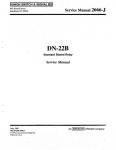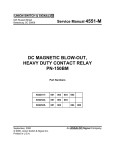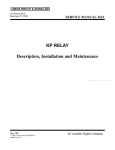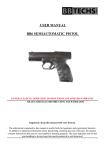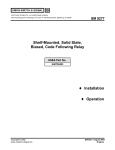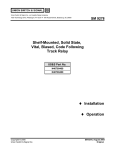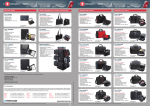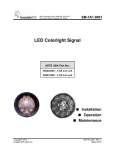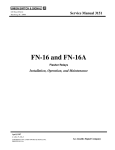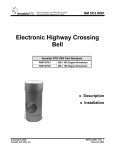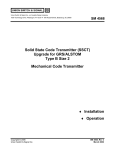Download SM-2666N - Ansaldo STS | Product Support
Transcript
645 Russell Street Batesburg, SC 29006 Service Manual 2666N DN-22B Special Biased Relays for Third Rail Indicator March, 2000 © 2000, Union Switch & Signal Inc. Printed in U.S.A. An ANSALDO Signal Company Revision History October, 1950 March, 2000 Table of Contents Section Description Page 1.0 GENERAL INFORMATION................................................................... 1-1 1.1 Introduction ........................................................................................... 1-1 1.2 Shock Indicators.................................................................................... 1-1 1.3 R.A.I.L. Team and Technical Support ................................................... 1-1 2.0 MAINTENANCE.................................................................................... 2-1 2.1 Armature Air Gap .................................................................................. 2-1 2.2 Assembling............................................................................................ 2-1 2.3 Contact Adjustment ............................................................................... 2-1 2.3.1 Front Contacts....................................................................................... 2-1 2.3.2 Back Contacts ....................................................................................... 2-1 2.4 Calibration ............................................................................................. 2-2 2.4.1 Drop-Away............................................................................................. 2-2 2.4.2 Pick-Up.................................................................................................. 2-2 2.4.3 Working ................................................................................................. 2-2 2.5 Service Tests ........................................................................................ 2-2 2.6 Check of Permanent Magnet................................................................. 2-3 2.6.1 Reverse Pick-Up ................................................................................... 2-3 2.6.2 Hold-Down Torque ................................................................................ 2-3 LIST OF TABLES 2-1 Calibration Values for Special DN-22B Relay with 2F-2B L.V. Contacts and Small Backstrap .............................................................. 2-3 2-2 Contact Resistance ............................................................................... 2-4 SM-2666N (03/00) i Table of Contents This page is intentionally blank. ii SM-2666N (03/00) 1.0 General Information 1.1 INTRODUCTION For other information see Service Specification 2666. This service manual covers DN-22B special biased relay P/N N277655, used for a third rail indicator. The instructions in Service Manual 2666 (Standard DN-22 Relay) apply for DN-22B special biased relays, except as otherwise specified herein. The DN-22B special biased relay for a third rail indicator is similar to the standard DN-22B biased relay (Service Manual 2666-J) but has a copper sleeve on the front core and an ordinary-acting coil on the rear core. The relay has insulated nuts to protect against the high voltage circuits to the relay binding posts 1.2 SHOCK INDICATORS WARNING: ANY RELAY SHOWING SHOCK INDICATOR ACTIVATION SHOULD BE SHOPPED BEFORE PLACING RELAY INTO SERVICE. FAILURE TO ASSURE PROPER FUNCTION OF THIS RELAY MAY RESULT IN SEVERE PERSONAL INJURY OR DEATH. The shock indicator (P/N J680167-0012) shows red when the relay has been subjected to shock in excess of a safe level (i.e., dropped) during shipment or transport. This is an indication that the relay may have mechanical damage and may not meet electrical specifications. The relay should be opened and visually inspected for damage (i.e., kinked springs). Mechanical settings should be checked, recalibrated, and tested according to specifications by a qualified individual. 1.3 R.A.I.L. TEAM AND TECHNICAL SUPPORT The Rapid Action Information Link (R.A.I.L.) Team is comprised of a group of experienced product and application engineers ready to assist and resolve any technical issues concerning any US&S product. Any questions regarding the contents of this Service Manual can be answered by contacting the R.A.I.L. Team toll free at 800-652-7276 or via Internet e-mail: [email protected]. SM-2666N (03/00) 1-1 1.0 General Information This page is intentionally blank. 1-2 SM-2666N (03/00) 2.0 Maintenance 2.1 ARMATURE AIR GAP The armature air gap should be adjusted as closely as possible to 0.018" parallel (0.019” if the rust protective coating has been removed from the pole faces). The physical air gap after painting should not be less than 0.017”. If it is necessary to repaint the pole faces, we recommend that Union Pole Face Treatment per Instruction Pamphlet U-5038 be used. This pamphlet also covers an aluminum paint material for touching up armatures, backstraps and similar parts. 2.2 ASSEMBLING Assemble the permanent magnet to the relay and adjust, using a spacer 0.095” thick at the main upper stop-pin, so that the magnet clears the armature lower stop pin by approximately 0.001”. For this adjustment do not energize the relay to hold the armature against the spacer, but hold it manually to bring the armature as close to the pole pieces as the spacer and the pivot clearance will permit. 1. The spacer used for adjustment may be changed between the limits of 0.085” to 0.105” if necessary to meet calibration requirements shown in Table 2-1. 2. With the adjusting spacers removed and the armature released, at least 50% of the armature lower stop pin should rest on the permanent magnet shoe. 3. The air gap between the armature and the permanent magnet should average 0.004” but should be not less than 0.003” at any point. 4. The magnet must be securely clamped and the screws properly locked with the nut lock provided. 2.3 CONTACT ADJUSTMENT 2.3.1 Front Contacts Front contacts should be adjusted using a 0.035” normal spacer at the main stop pin. A spacer .001” thinner should allow contacts to close. A change in spacer is permissible if needed to meet calibration requirements; however, the minimum allowable contact setting is 0.030”. 2.3.2 Back Contacts Back contacts should be adjusted to all make together and to have least 0.050” opening when the front contacts are just making. This can be accomplished by adjusting them with a spacer at the stop pin 0.035” thicker than that used for adjusting the front contacts. Thus, if a 0.035” spacer has been used for adjusting the front contacts, a 0.070” spacer should be used for the back contacts. A space of .001” thinner should allow contacts to open. SM-2666N (03/00) 2-1 2.0 Maintenance With the back contacts closed and with the armature against the permanent magnet, the contact opening should be at least 0.075”. With a 0.016” thick spacer between the permanent magnet and the stop pin on the underside of the armature, verify that the back contacts remain closed. 2.4 CALIBRATION Before calibrating, the relay should be energized at the charge value given in Table 2-1; and the energization polarity should be changed several times, allowing the current to build up to full value in each direction. When the positive power lead is connected to the "+" coil terminal, the armature should pick up. When the polarity of the power supply is reversed so that the negative power lead is connected to the "+" coil terminal, the armature must not pick up. 2.4.1 Drop-Away The relay shall be energized at the charge value with normal polarity; and the voltage then gradually reduced until the armature drops away, opening all front contacts. This value shall not be less than that specified in the table for “minimum drop-away.” The voltage should be further reduced gradually until the back contacts are fully compressed with the armature against the permanent magnet shoe. The energization at which this occurs shall not be less than the table’s value for “minimum drop-away full back contact pressure.” 2.4.2 Pick-Up Immediately after the drop-away value has been measured, the voltage shall be reduced to zero, the circuit opened for one second and then closed. Gradually increase the voltage until the armature moves away from the permanent magnet with a very definite sudden motion. This value shall not be more than 90% of the actual pick-up value measured. The voltage shall then be increased gradually until the armature picks up and the front contacts make. This value shall not be greater than that specified in Table 2.1. 2.4.3 Working This value shall be obtained immediately after pick-up by further increasing the voltage until the armature completes its motion and closes against the stop pin. This value shall not be greater than that specified in Table 2.1 for “maximum pick-up and working.” 2.5 SERVICE TESTS It is recommended that the following calibration limits be used to determine when relays should be removed from service. 2-2 SM-2666N (03/00) 2.0 Maintenance 1. When the drop-away of line relays falls below 67% of table value; or when the drop-away of track relays falls below 85% table value. 2. When the drop-away for full back contact pressure falls below 25% of the table value. 3. When the pick-up increases above 110% of the table value. For field tests it is satisfactory if the armature picks up directly from the permanent magnet, providing the 110% allowance is not exceeded. 4. When the working is above 110% of the table value. 2.6 CHECK OF PERMANENT MAGNET 2.6.1 Reverse Pick-Up The armature shall not pick-up or move away from the permanent magnet when the relay is energized with a reverse polarity energization (negative lead on the “+“ coil terminal) equal to the “charge” value shown in Table 2-1. 2.6.2 Hold-Down Torque This check can only be done with the cover removed. With the relay in the normal upright position and with the coils deenergized, a force of 100 grams applied on the front edge of the full thickness portion of the armature shall be required to cause the armature to move away from the permanent magnet. This check shall be made after energizing the relay at the charge value with normal polarity of energization. TABLE 2-1 CALIBRATION VALUES FOR SPECIAL DN-22B RELAY with 2F-2B L.V. Contacts and Small Backstrap Air Gap = 0.019” Parallel Resistance of Coil Ohms 1000 Charge Minimum DropAway Min.DropAway Full Back Cont. Pressure Max. Pick-up and Working * Volts Amps. Volts Volts Amps. Volts 31.8 0.0039 3.9 2.6 0.0079 7.95 * Working is the same as Full Stroke. SM-2666N (03/00) 2-3 2.0 Maintenance TABLE 2-2 CONTACT RESISTANCE Contacts Silver to Silver Silver to silver-impregnated carbon 2-4 Front Back -0.09 Ohm 0.03 Ohm -- SM-2666N (03/00)












